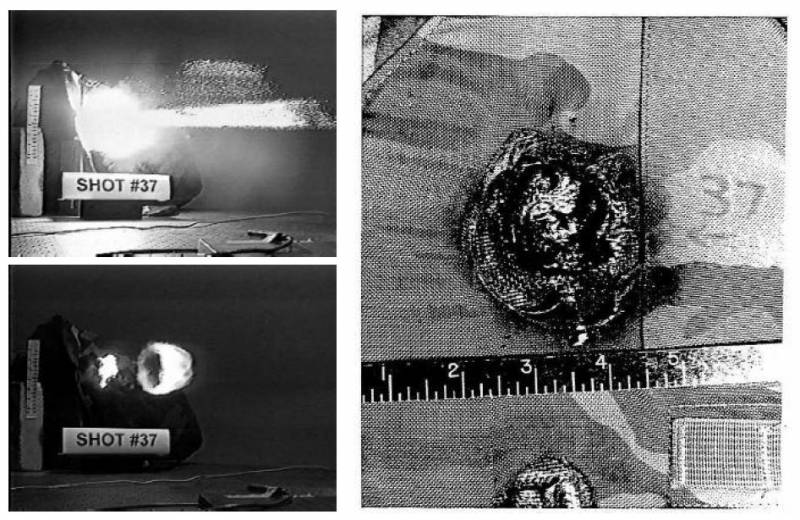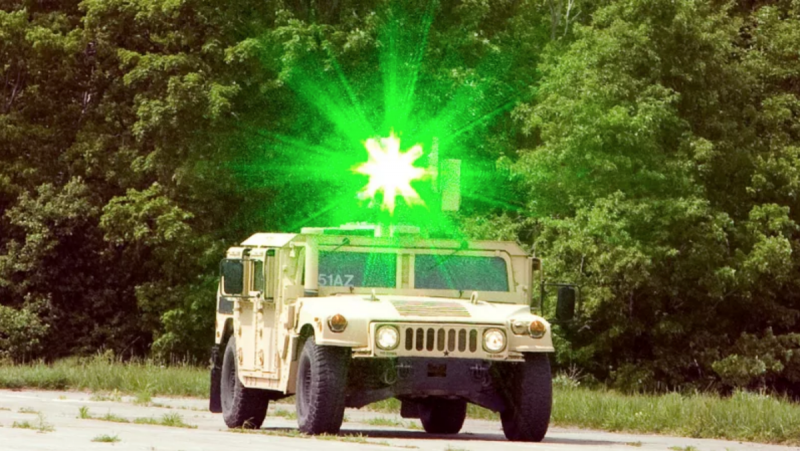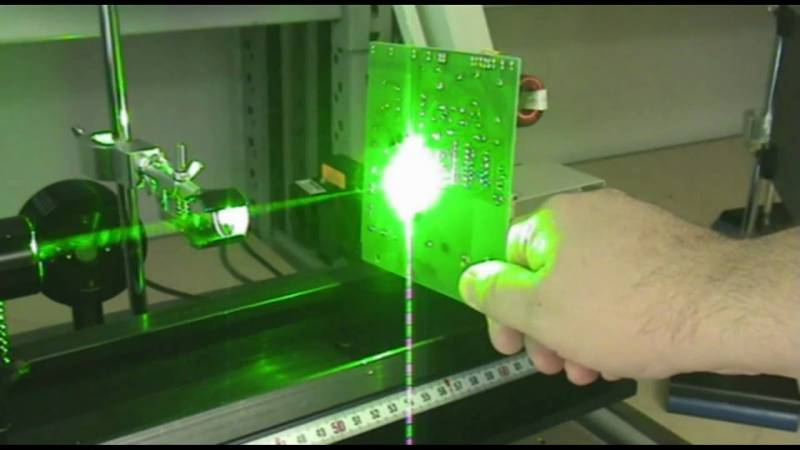From the computer game on the battlefield: plasma weapons

Joules to target
First, a little theory. If we abstract from computer shooters, then it is not easy to define plasma arms. Forcing plasma to concentrate into high-density beams and throwing this essence through gun barrels will only work in science fiction films.
Strictly speaking, a plasma weapon or a cannon refers to electrothermal accelerators that accelerate a projectile by discharging plasma between electrodes. Another name is the plasma railgun. Of course, such toys require wagons of electricity that fit in multi-ton capacitors. Therefore, if plasma guns appear in the series, then first of all on ships.
But in foreign literature, the term Plasma Weapons is used in relation to laser installations. What's the catch here? It's all about the combined action of the laser beam on the target, which will be discussed below.
PIKL Program. The most deadly of the American laser weapons programs can be considered the PIKL project, which started in 1992. The level of developers is impressive - Los Alamos National Laboratory (designers of a high-pulse infrared-pumped laser) and the Armstrong Laboratory, which is responsible for evaluating the effects of weapons on biological tissues. The latter office was engaged in projects in the interests of the US Air Force.
In the course of work on the PIKL (Pulsed Impulsive Kill Laser) project or “Pulsed Killing Laser”, an unusual effect on the target was revealed. It consists in the formation of a plasma ball, the electrons of which absorb laser radiation, and then an explosion followed, significantly increasing the damaging effect on the target.
Initially, the plasma did not let the laser through at all, and no explosion happened - in fact, the weapon independently formed armor on the object of attack. But the testers increased the energy of the laser pulse, the plasma cloud instantly overheated and was discharged by an explosion. Actually, it is for this reason that the term Plasma Weapons or plasma weapons has taken root abroad. Working on the target with a laser, the installation formed a “damaging element” on the object in the form of an explosion of a plasma ball.
In 1992, the first prototype of the PIKL Program laser (plasma) installation was built, generating pulses of 100 Joules with a duration of 10 microseconds. The product turned out to be heavy, and even often failed - mainly due to depressurization of the circuits.

The results of testing plasma weapons at the Armstrong Laboratory
By 1993, a new smaller prototype had been built, firing pulses of 3–5 microseconds with an energy of 126 Joules. By the end of 1993, the installation was made even more powerful - the laser pulse energy reached 300 Juol.
For testing at the Armstrong Laboratory, mock-ups of targets imitating human skin, as well as Kevlar body armor, were prepared. The leather was replaced by soaked suede, laid on blocks of ballistic gel. The latter was supposed to imitate human flesh. For testing on the target, a laser beam 3 by 2 cm in size was formed.
An explosive effect was observed when working with a laser pulse of 400 Joules - a pressure of 25 atmospheres was recorded on the target. The event was accompanied by a loud pop and flash, as if the simulator was hitting an explosive projectile. Such injuries cannot be called fatal; rather, they were non-lethal injuries, although very sensitive.
The range of the PIKL laser was up to 2 km, while the range of use was unusually wide - the destruction of the dynamic protection of armored vehicles, the defeat drones, injuring (and often killing) manpower, as well as dispersing demonstrations. The product had undoubted advantages - a unique rate of fire, noiselessness, high accuracy and range. True, it was possible to defend against such weapons with simple aerosol clouds, and sometimes with a smoke screen.
Pulsed Energy Projectile or PEP. This is the next step in the American laser (plasma) weapons program.
A set of effects similar to the PIKL Program - an invisible laser forms a plasma explosion on the object, which stuns the victim, and also affects the nervous system. Most often, powerful electromagnetic radiation causes a short-term pain shock, similar to a cold burn, and partial paralysis. Some of the victims experienced "motor effects similar to those of a stun gun."

Pulsed Energy Projectile or PEP
Unlike classic non-lethal weapons, a plasma gun can send you to the next world. Especially if the patient suffers from chronic diseases of the heart or nervous system. This is not surprising, since the Americans planned to use PEP not against relatively healthy military personnel, but against unruly crowds of civilians.
The PEP installation is made on the basis of the HMMWV SUV, pulls 230 kg and is able to work on targets at a distance of 2 km. The high-energy infrared laser, as in the PIKL Program, is made on deuterium fluoride and is invisible to the human eye. This adds suspense when dispersing the crowd - no one sees where the law enforcement officers are working from, which makes orientation even more difficult.
The program, which started in the 2000s, was shut down, allegedly citing excessive cruelty. In fact, the authors could not fine-tune the stun and pain effects of the weapon. If it was well suppressed by the plasma strike, then the painful effect of the electromagnetic pulse was prohibitive. As soon as the pain effect was reduced to an acceptable level, there was no stun as such.
Instead of a thousand suns
Plasma Acoustic Shield or PASS is a non-lethal weapon, which is also based on a solid-state laser. The principle of operation is similar to the above installations - the laser creates a plasma cloud in the air with the first pulse, and undermines it with a second pulse at supersonic speed. The developers assured that they could create deafening fireworks in front of any object.
The rate of fire is up to 10 pulses per second, which should stop the most determined intruder. Potentially, an increase to 200 rounds per second allows you to cross the threshold of non-lethality and kill a person.
Developer Stellar Photonics has been designing PASS since 2005, and all was well until it came to powering the voracious laser machine. The weight of the product in the most advanced version reached 230 kg, which required a mobile carrier. But even in this case, the supply of shots was limited - recharging the batteries required a lot of time.
Although, of course, the effectiveness of the use was remarkable - in some cases it was possible to draw symbols in the air with a series of explosions. Or beat with special impulses on the windshield of approaching cars. For example, at checkpoints. Only the fireworks were short-lived.
In 2008, the military rightly rejected PASS due to its excessive cost, gluttony and massiveness. A simple burst from the assault rifle into the air will have more effect than a whole HMMWV with a laser on the roof.

But the Americans did not calm down, and in 2018 they started the project SCUPLS or Scalable Compact Ultra-Short Pulse Laser System. We worked on the wavelength of the laser - now it is safe for the retina. The laser hits one kilometer and creates a light and noise effect at a level of 165 decibels. It's like being near the nozzle of a jet plane taking off.
The logic of work is the same - the first pulse creates a plasma cloud, the second one heats it up to detonation. The developers claim that even commands can be transmitted over a distance with such an algorithm. For example, a request to stop. A special low-level mode of operation is provided for this. If the object does not understand, then it receives the entire range of laser-plasma weapons - fireworks (intensity of 6-8 million candela), stunning, disorientation, paralysis and cold burns on the skin.
All of the above for the time being belongs to the category of non-lethal weapons. But one has only to tweak the settings, find the appropriate batteries - and the plasma weapon turns into a combat one. With unpredictable effect on the battlefield.
Information